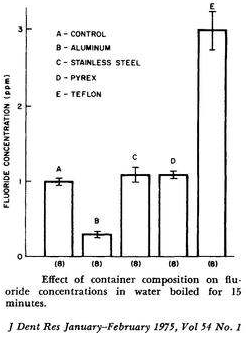In 1975, Full and Parkins reported in the Journal of Dental Research that boiling water in teflon plans produced a “pronounced increase” in fluoride levels. An excerpt from this study is reproduced below. Teflon is made from fluorinated chemical, and thus the relationship between Teflon use and fluoride contamination of food is plausible.
The following is an excerpt and figure from the Full and Parkins study:

“The fluoride concentrations observed before and after boiling for each container and the change in fluoride concentrations are shown in the illustration. A pronounced increase was seen with the Teflon-coated vessel. The boiled water from the aluminum vessel showed notable decrease. Little change was noted in the fluoride concentration of the water boiled in the stainless steel and Pyrex vessels. The amount of water remaining in each vessel was estimated; in the aluminum, stainless steel, and Pyrex vessels water was reduced by a third and in Teflon by a half. . . .
The variation of fluoride content in foods prepared in cooking vessels of different compositions should be studied. The magnitude of the composition effects seen with the aluminum and steel containers suggests that significant alterations in fluoride uptake into boiled foods may occur.”
Despite the potential significance of these findings to the fluoride exposures of millions of Americans, there has been virtually no careful attempt in the subsequent 37 years to replicate the findings. One small-scale study in a state dental journal (that FAN does not have a copy of) apparently found no increase in the fluoride content from Teflon use, but such a small obscure study can hardly be deemed sufficiently adequate to resolve the issue one way or the other.
SOURCE: Full CA, Parkins FM. (1975). Effect of cooking vessel composition on fluoride. Journal of Dental Research 54: 192.
